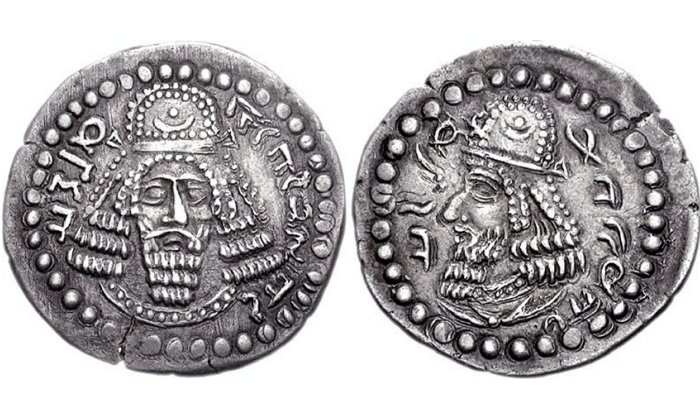David Tee - AncientPages.com - The area deemed today as Iran has had a long history. The Medes first ruled the nation in the 9th century BC. However, the Persians occupied Pars, and their name is associated with that region.
Initial coinage of founder Ardashir I, as King of Persis Artaxerxes (Ardaxsir) V. Circa CE 205/6-223/4. Obv: Bearded facing head, wearing diadem and Parthian-style tiara, legend "The divine Ardaxir, king" in Pahlavi. Rev: Bearded head of Papak, wearing diadem and Parthian-style tiara, legend "son of the divinity Papak, king" in Pahlavi. source
Different empires and conquerors have taken over the Iranian region through the years, including Alexander the Great and the Parthians. It was against the Parthians in 200 AD that Papak, the father of Ardashir I, and a Persian prince, who ruled Pars at the beginning of the third century, began his revolt and started to build a power base.
His death was the only thing that stopped Papak from becoming the first Sasanian ruler. After a power struggle with his brothers, Ardashir I became the first Sasanian ruler. Between 208 and 224 AD, Ardashir I fought his brothers, and finally, he executed them. He established the Sasanian empire, which lasted between 224 to 651 AD. At this time, the term "shah" was used to indicate ruler or king, and Ardashir I took the title 'Shahanshah' - King of Kings of Iran.
Important Sasanian Rulers
The Sasanian Empire lasted for over 400 years. During this time, many of its rulers excelled at different tasks, and it wasn't easy to pinpoint which were more significant than the others.
After Ardashir I came Shapur I, 215 to 270 AD, but his claim to fame was mainly that he legitimized the Sasanian rule and helped solidify their hold on what is now called Iran. He was also a warrior king who could attack and exploit the weaknesses of the declining Roman Empire.
One of his military successes was the agreement between Shapur I and Philip the Arab, 244-249, whereas the latter received support for his rule over Rome by handing Shapur I Armenia.
Shapur II, 307 to 379, came to the throne of the Sasanian empire before he was born. His father was murdered, and he was crowned Shah before his birth. It seemed like a wise decision as Shapur II served his people well and expanded Sasanian territory at the expense of the Roman Empire.
Khosrau I, 501-579, was probably the most beloved Shah of all the Sasanian rulers. During his reign, he enacted various reforms, including the taxation system, which helped the Empire survive for another 100 years.
Besides this and his military reforms, Khosrau I is known for his literary and academic achievements. His Academy of Gundeshapur was one of the most respected learning centers in the known world at that time.
Part of his legacy would include his many building projects that included hydraulics. He rebuilt canals and farms to help strengthen his kingdom.
The Fall Of The Sasanian Empire
The Sasanian Empire started to fall apart when Khosrau's son, Khosro II 591-628, assumed the throne. Raised in an era of peace and luxury, Khosro II was wasteful and not a very good ruler.
While he successfully captured Jerusalem in one battle, his subsequent loss of the city allowed his enemies to make considerable inroads into his territory.
After his rule was over, his son, Yazdgird III, 624 to 651, came to the throne when he was 8. Yazdegerd III spent most of his reign on the run, losing much of the territory his ancestors had gained.
It is said that Yazdgird III was murdered by a peasant in 651.
Legacy Of The Sasanian Empire
Although the Sasanian Empire was known as the last Empire before the Muslim invasion and rule, it was not without its high points.
One of its most significant achievements is that Shah Khosrau established an excellent learning center. The Babylon Talmud was written during the time of the Sasanian Empire, and Sura and Pumbedita (the two most famous academies) became a vital part of Jewish scholarship.
Along with its influence on Rome, the Sasanian Zoroastrians moved to India to escape Islamic persecution. Their presence did play a role in the development of that country.
Written by – David Tee AncientPages.com Staff Writer
Updated on October 29, 2022
Copyright © AncientPages.com All rights reserved. This material may not be published, broadcast, rewritten or redistributed in whole or part without the express written permission of AncientPages.com
Expand for referencesReferences:
Daryaee T. Sasanian Persia The Rise and Fall of an Empire
Pourshariati P. Decline and Fall of the Sasanian Empire
